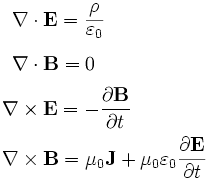Physicists speak math. When they want to communicate clearly with one another, it looks a lot like this:

It’s tight. It’s clear. It’s unambiguous (as long as you know how to read the symbols). It’s also completely unlike how most people communicate.
Much of the coursework in physics education programs involves simply learning to read this set of arcane symbols, because they are powerful beyond words. Literally. The manipulation of these symbols, when it becomes second nature, allows people to derive and arrive at conclusions that are valid representations of the world, to which they could not have arrived through the use of “mere” language, with all its ambiguities. (Oh, language friends, don’t jump all over me. It’s in quotes for a reason. I’ll get there.)
(Since I started writing this, The Atlantic pointed it out, but let’s pretend that it’s an original thought, since I’ve been ruminating on this post for about a year and a half, and without it, the rest of the argument falls apart.)
Math is what I call a field language… that is, it (potentially) describes not just the phenomenal world, but the reality that lies beneath. The equations and functions we write down and ponder describe something inherent about the universe. Light waves always propagated in ways consistent with the rules described above. Planets always moved in elliptical orbits in which the swept out area was a constant. We do not impose order on these systems, we learn to describe what is already there in precise terms. This is science. We seek means of describing the field, That Which Is and the rules that govern it, by observing the phenomena, That Which We Can Observe. If I replace a 2 with a 3 in one of my equations, it doesn’t change how the universe works; it just means that I’m wrong about it. I don’t have to believe it for it to be true.
This should be compared with social constructions of reality. These are systems that exist in the universe, but only so long as people agree to them. They wind up being local systems of order, not universals. The locally constructed reality is more like a landscape, or a profile of what plants and animals are in the area, than it is a valid construction of the universe as a whole. It’s a real thing that must be navigated and explained, but there is an aspect of it in which everybody agrees to act as if substituting a 3 for a 2 changes the way the world works. It does, but it changes not the way that light propagates, but the way that we expect people to behave when considering how light propagates. We are collectively, for want of a better word, wrong. But we have plenty of evidence that we (collectively) prefer to defend the socially constructed reality than to acknowledge the collective error.
***
Many of our difficulties arise from the attempt to use phenomenal languages to describe the noumenal. Language simply hasn’t evolved for that. It is a way that we make explicit our experience of the phenomenal world, including our internal states. I realized this (I’m afraid) by overhearing conversations. Almost everything we say to one another is essentially orientation. “This person is like this. I found this good thing to eat. Did you hear that new band?” Or requests for orientation, “What do you think he meant when he said that? Where’s the best place to get a new bed? How do you renegotiate a mortgage?” We wander through the world on a constant sonar mission: Ping, ping, ping… this is what I perceive. What do you perceive? (variously calibrated to accept or reject feedback!) But we get hung up on our internal states. “How does that feel? How does that feel? How does that feel?”
Science gets hung up on these places that we lack the language to describe, and the tools to probe. It is stuck asking such precise questions as, “What part of the brain lights up when you do this?” Which simply doesn’t address the key question, “What is it like to be a person having this experience?” The language that people use to bring their inner space out into the world is imprecise, inaccurate, misleading, and can be completely dishonest. Yet we are the sorts of creaters who need to bring the Other into resonance with the Self so that we can share the experience. There is a communal aspect to experience; each of us as individuals trying to bridge the space between us and the other.
This is where art comes into it… I suspect that art and poetry are also field languages, things which penetrate consciousness to describe what lies beneath. Maybe not with the precision of math, but it doesn’t mean that the perception is inaccurate… it means that the description is incomplete, given the limitations of language, and the resonance it attempts to call forth is (perhaps) damped as a result. When I consider the process of making poetry, I consider it an attempt to capture ephemeral, implicit realizations about the nature of reality and place them into the realm of the explicit… And as I considered my own process I realized that when I pick a word that has ambiguous meaning, it is intentional. The ambiguity is part of the poem, so that it operates on many different layers at the same time. Our sacred texts, in all our various religions, were written in this poetic method, so when we attempt to translate them, we wind up with such awkward illuminations as, “All dharmas are empty… in this case, dharmas refer to phenomenon, rather than to the Buddha’s teachings.” How do we know that? In the mind of the poet, in the speaking of the field that comes through the heart sutra, if it is like other poetry (and we have no reason to believe that it isn’t), “dharmas” has all its meanings at the same time… dharma is the teachings, and the phenomenon, and the essence of each thing, and right action. It is all the meanings of dharma simultaneously. That’s the power of a sutra. That’s why the yoga sutras have, like, 4 words per line, but the illuminations are dozens (or hundreds) of pages long.
Let us consider the world of “spiritual practice” and the nigh-impossibility of communicating these experiences to people who haven’t… um… experienced them. We know, for example, that intense emotions have a tendency to reinforce the conditioned self, so we try to figure out ways to reduce them. Yet for so many people, the intense emotion of self-loathing leads to spiritual bypassing, refusing to deal with the emotions as they arise, as “good spiritual people don’t have these problems”, and it doesn’t work. Again. Because we don’t have a way to explicitly talk about shades of emotions, alignment, finding our way through consciousness gradients that include so many shadow emotions.
It’s the problem that I’m having right now. How do I write down the surfaces and flows of energy that I see/feel when I can’t write down the equations for them? How do I explain the visceral difference between all the various shades of pleasure, some of which have the character of letting myself bounce off reality, and some of which feel completely aligned? How do I explain my experience of the reduction of emotional “charge” without it sounding like I’ve just become numb?
So we teach, and we practice, and we practice, and we teach the practices… murmuring, “And as you feel your way back into alignment in this asana, take a moment to be curious about how you feel about the pose. Just notice, and then let it go.” And you hope that people have read their sutras, understand that the self they bring to the mat (or the cushion, or the ritual space) is the same self they bring to the office (or the classroom, or the dinner table) and the work on the mat illuminates the sutras. That the sutras are self-illuminating, as long as the practices are undertaken.
And I find myself yearning for the clarity of mathematics.

3 responses to “Problems of Translation”
1) The clarity of mathematics is built upon axioms universally accepted by those who speak math. What is axiomatic in the realms you want to describe?
1. That the universe exists. ∃ universe
This, I certainly can’t prove.
2. That it is made of quantized pieces. ∃ (fundamental particles)
3. That those quantized pieces exchange information with one another that provide them with information regarding their own space-time trajectory. ∃ (exchange particles)
Do those count as axioms?
Sure. Why not?